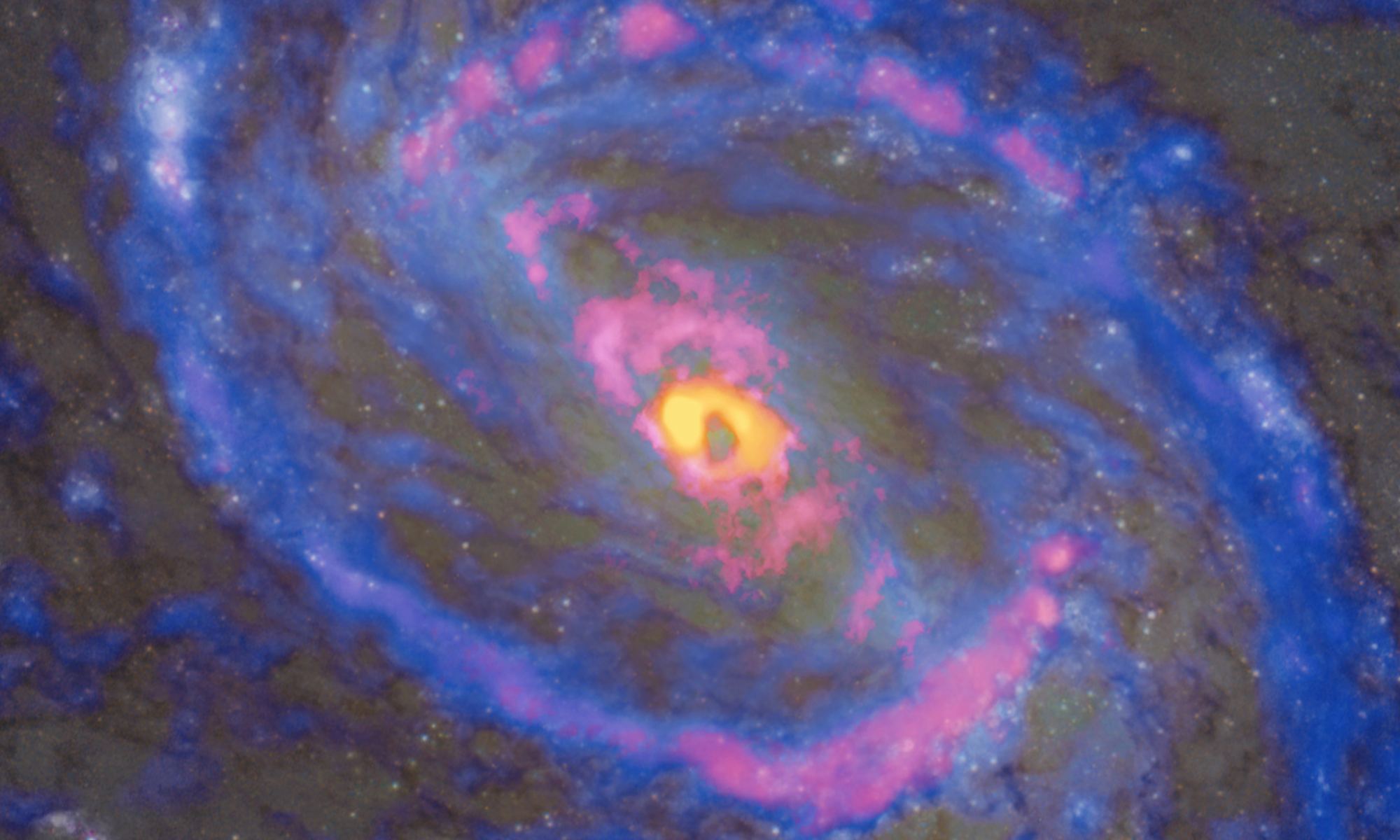Supermassive Black Holes (SMBHs) are impossible to ignore. They can be billions of times more massive than the Sun, and when they’re actively consuming stars and gas, they become luminous active galactic nuclei (AGN.) A galaxy’s center is a busy place, with the activity centred on the SMBH.
New research provides strong evidence that while going about their business, SMBHs alter their host galaxy’s chemistry.
Astrophysicists know a lot about SMBHs and their powerful effects on their host galaxies. It looks like most massive galaxies are anchored to an SMBH at their centers. Nothing can escape from their overwhelming gravitational grip. Even light is powerless. SMBHs are responsible for active galactic nuclei, which emit powerful energy across all wavelengths. The energy comes from the swirling torus of attracted material that surrounds an SMBH prior to falling into the hole.
Researchers also know that SMBHs create black hole feedback. The center of large galaxies contains lots of hot gas dense enough that it should cool down over tens to hundreds of millions of years. This should mean that cool gas funnels toward the center. This cooling flow should lead to massive starbursts near the center of the galaxy. But generally, that’s not what astrophysicists see.
Instead, it looks like the SMBH launches powerful jets of material into the surrounding gas, keeping it hot and preventing the cooling flow and the resulting bout of intense star formation. That’s black hole feedback.
These are just some of the ways that black holes change their surroundings.
New research shows how an SMBH changes the presence and distribution of chemicals in the host galaxy. The study is “Molecular Abundance of the Circumnuclear Region Surrounding an Active Galactic Nucleus in NGC 1068 Based on an Imaging Line Survey in the 3 mm Band with ALMA.” It’s published in The Astrophysical Journal, and the lead authors are Toshiki Saito at the National Astronomical Observatory of Japan and Taku Nakajima at Nagoya University.
Dust and gas block our view of the centers of galaxies, and it takes special observing capabilities to see inside. The Atacama Large Millimeter/submillimeter Array (ALMA) is a powerful grouping of 66 radio telescopes that work together to create impressive observational power. The researchers used ALMA to map out the presence of chemicals in the barred spiral galaxy NGC 1068, known more popularly as M77, or the Squid Galaxy. They also used a new machine-learning technique and mapped the distribution of 23 separate molecules.
The research team focused on two parts of NGC 1068: the circumnuclear disk and the starburst ring.
A starburst ring (SBR) is a prominent feature in some galaxies where pressure waves from the core collide with gas to cause abundant star formation. There could be other causes of the starburst, too, including galactic mergers or gravitational interactions with other galaxies. NGC 1068 has a starburst ring, and the galaxy is also referred to as a starburst galaxy.

A circumnuclear disk (CND) is a ring of molecular gas that orbits an SMBH. Astrophysicists aren’t certain how these structures form or if they’re stable or transient. But they can contain an enormous amount of material. The Milky Way’s black hole, Sgr A*, contains tens of thousands of solar masses. The CND is closer to the SMBH than the SBR.
The researchers also identified two prominent knotty structures in NGC 1068 that they call the ‘E Knot’ and the ‘W knot,’ which are parts of the CND.

The researchers mapped the chemicals throughout both regions and found different distributions of different chemicals.

NGC 1068’s SMBH emits powerful polar jets that seem to alter the chemistry. Carbon monoxide (CO) is a common molecule in galaxies, and the energetic jets seem to break it down. There’s less of it in the CND, which is much closer to the SMBH than the SBR.
The team also found unexpected concentrations of hydrogen cyanide (HCN) in the CND, which could be the result of strong shocks that create higher temperatures. The CND also contained more H13CN, SiO, and H13CO+. Conversely, the CND contained less cyanide (CN) than predicted by models, due to strong radiation. Even though the powerful AGN is much closer to the CND, the team thinks that mechanical forces have a stronger overall impact on the chemistry, rather than X-rays from the AGN.
The researchers also measured the fractional abundances of the different chemicals by comparing them to carbon monosulfide (CS.) Astronomers use CS because it’s one of the best tracers of dense gas.

The research shows that the chemical abundances are different in different parts of the galaxy. Even the E knot and the W knot show different abundances.
The authors say that this work is the first molecular line survey with high enough resolution to see the internal structure of the CND at the nucleus in an AGN host of a nearby galaxy. NGC 1068 is a frequent object of astronomical study because of its proximity and luminosity, yet this is the first time that anyone’s ever detected silicon monoxide (SiO) there.
SiO is important in astronomy because it’s a tracer for shocks. Silicon is present in dust grains, and when the grains are shocked, it combines with oxygen to form SiO. Shock waves in galaxies compress, heat, and accelerate gas, resulting in dramatic alterations in chemistry. Shocks are responsible for the collapse of gas clouds into pre-stellar cores, which eventually become stars.
SMBHs and the entire centers of galaxies are difficult to observe. These ALMA observations are a detailed look at the region and its components, and which types of chemicals are more abundant. But it’s about more than just the presence or absence of specific chemicals.
These regions are anything but placid. Massive clouds of gas, intense X-ray and other emissions, shock waves, and the overwhelming mass of the SMBH are all interacting to encourage and quell star birth.
This research is just one more window into all that chemical and mechanical complexity.

